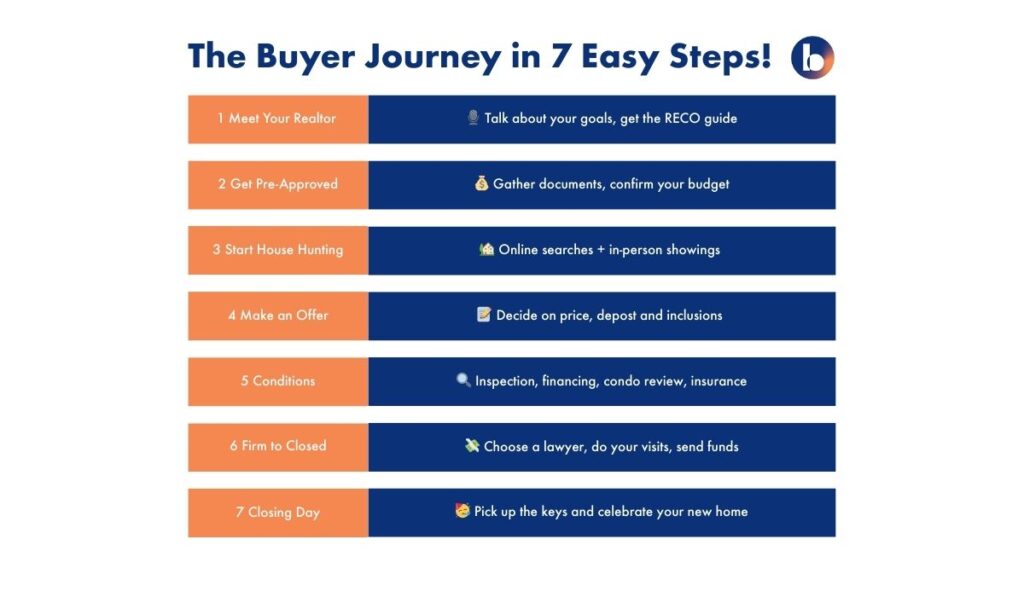Buying your first home is exciting, but it can also feel overwhelming. There’s so much information coming at you from all directions, and it sometimes feels like you’re supposed to just know what to do. We’ve been working with first-time buyers for years, and we know how confusing those first steps can be. That’s why we put this together. If you know someone who’s thinking about buying their first place, share this with them. It might be exactly what they need.
Step 1: Connect With a Trusted Realtor
The first step is finding an agent you trust. Lots of people start with a referral from friends or family. At your first meeting, you’ll talk about your goals, budget, and the type of property you’re looking for. You should also receive the RECO Information Guide, which explains your rights and what to expect when working with a realtor in Ontario.
Step 2: Talk to a Mortgage Professional
If you haven’t already been pre-approved, this is your next move. We often recommend a mortgage broker because they can shop your file with multiple lenders and help you find the best deal.
Be ready to provide a package of documents, such as:
-
- Government-issued photo ID
-
- Recent pay stubs and T4 slips
-
- CRA Notice of Assessments (last two years if you’re self-employed)
-
- Employer letter of employment or business financials
-
- Bank statements and proof of savings for your down payment
-
- Details of other debts (car loans, credit cards, lines of credit)
Your broker usually needs three to five days to review everything and let you know what you can afford.
If you’re using your RRSP through the Home Buyers’ Plan, your broker or bank rep will walk you through the paperwork (Form T1036). When it’s done properly, you can withdraw without tax penalties, but you’ll need to repay the funds gradually back into your RRSP.

Brokers work faster when you’ve got everything in order. Keep a digital folder with your ID, pay stubs, tax returns, and bank statements. It’ll save you days of back-and-forth.
Step 3: Start Your Home Search
Your realtor will set up an automated home search that delivers listings to your inbox. Remember that these searches only include exactly what you ask for. If your maximum budget is $800,000, the system won’t send you a house at $809,000 even if it might sell for less. It’s often wise to keep your search a little wider and less restrictive.
You can also keep browsing Realtor.ca or other sites. Share anything that interests you with your agent, even a private sale-by-owner, and they’ll dig into the details for you.
Step 4: Book Showings and Tour Homes
This is where things get exciting. Touring homes gives you a true sense of what’s out there. Try to give a little notice when booking, since last-minute showings are harder to arrange if sellers still live in the home. After each showing, your agent can help you review what you saw, compare the price to recent sales, and point out both positives and red flags.
A good agent will often spend more time pointing out why a house isn’t the right fit than trying to convince you to make an offer. That’s because the goal isn’t just to get you into a house, it’s to make sure you find the right home for your needs and your budget.
Step 5: Making an Offer
Once you’ve found the right place, you and your agent will prepare an offer. Together you’ll decide on:
-
- Price
-
- Closing date
-
- Deposit amount
-
- Inclusions (such as appliances or light fixtures)
-
- Exclusions
-
- Other concerns, like whether equipment such as a furnace or hot water tank is rented
You can also ask your agent to find out if the property has ever been used as a grow op, or if there’s been a violent crime or death in the home. Sellers aren’t required to volunteer this information, but if you ask directly, they must answer truthfully.

Furnaces, hot water tanks, and even water softeners are often rented. These costs can add up quickly, so always check what’s owned and what’s not before you sign.
Step 6: Paperwork and Deposits
When it’s time to sign, pay close attention. Never just “sign here and here and here” without knowing exactly what you’re signing. Your realtor should walk you through each page and answer your questions.
Once the offer’s accepted, your deposit is due within 24 to 48 hours. This is often up to five percent of the purchase price. The deposit is held in trust by a brokerage or law office and is protected by insurance.

Your realtor is legally required to comply with federal FINTRAC reporting rules (Canada’s anti–money laundering legislation). This means you’ll need to provide government photo ID and details about the account your deposit comes from, including the account number. It’s routine for every buyer and nothing to worry about, but good to know in advance so you’re not surprised when asked.
Step 7: Conditions and Inspections
Common conditions include:
-
- Home inspection (typically $400 to $500 -> money well spent
)
- Home inspection (typically $400 to $500 -> money well spent
-
- Financing approval for the specific property
-
- Insurance approval (for properties with characteristics that could make them hard to insure)
-
- Review of condo documents (if applicable)
-
- Septic and well inspections for rural properties
An inspection’s meant to uncover major surprises, not to renegotiate over minor issues like chipped paint or outdated items that were obvious on your showings at the property. You should know where your line is for walking away if a serious problem is revealed.

An inspection’s not for chipping away at the price over small fixes. Concentrate on big surprises like foundation/structural issues, roof problems, or outdated electrical/plumbing.
Step 8: Mortgage Finalization
Your mortgage broker and realtor will work together to make sure the lender has everything they need. The lender will confirm both your finances and the property value before giving final approval. Once your conditions are satisfied, you’ll sign a notice of fulfillment. At this point, your deal is firm and you’re well on your way to becoming a homeowner. (This is when the SOLD sign goes up and things feel REAL for most buyers! 
A Note About Today’s Market
First-time buyers are leading the charge right now, especially in the more affordable price ranges. The most desirable properties in this group are beginning to attract multiple offers. It’s not the frenzy of 2021, but you’ll need your agent to guide you through how competition works. Unless you’re a qualified builder, contractor, or engineer, it’s usually wise to keep your financing and inspection conditions in place even in multiple offers.







